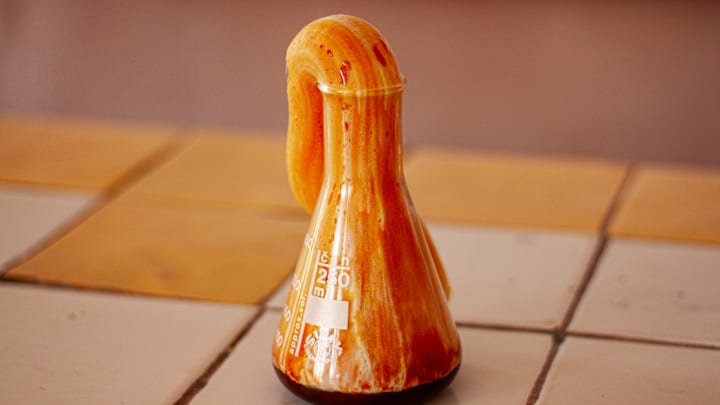While some science experiments are best left to experts (or no one), others are safe enough to try at home with kids. One that falls in the latter category is known as “elephant toothpaste”—and the recipe might not even require a trip to the store.
Why Is It Called Elephant Toothpaste?
First off, elephant toothpaste has nothing to do with actual elephants or toothpaste. It’s a kind of foam that, as it explodes out of a cylindrical container, looks a bit like toothpaste being squeezed out of a tube. And because there’s way more foam than you could fit in a regular-sized toothpaste tube, it seems like an animal much larger than a human—say, an elephant—would use it.
How the Elephant Toothpaste Chemical Reaction Works
As Scientific American explains, elephant toothpaste results from speeding up the reaction that occurs when hydrogen peroxide (H₂O₂) breaks down into water and gaseous oxygen. To do this, you need a catalyst: a substance that makes a chemical reaction happen at a quicker-than-normal rate. The catalyst in this case is dry yeast, which harbors a certain enzyme—catalase—known for swiftly breaking down hydrogen peroxide.
But before you add the yeast, you toss in some dish soap, which increases the surface tension across the hydrogen peroxide. Then, when the yeast causes oxygen to break off and form bubbles, they won’t burst right away—and the foamy concoction will pour forth from its receptacle.
A Kid-Friendly Elephant Toothpaste Recipe
By this point, you’ve probably already gathered that you’re going to need hydrogen peroxide, dish soap, and dry yeast. In Science Bob’s recipe, he recommends 6 percent hydrogen peroxide over 3 percent (which won’t generate quite as impressive an eruption). You’ll also need a 16-ounce plastic bottle, 3 tablespoons of warm water, and food coloring. Safety goggles are recommended for safety purposes, plus a funnel for easy pouring.
First, pour 3/4 cup of hydrogen peroxide into your bottle, and then squeeze in roughly 10 drops of food coloring. (Scientific American suggests adding your food coloring toward the top of your bottle, so it runs down in streaks along the inside. That way, your foam will have toothpaste-like stripes.) Next, pour in about a tablespoon of dish soap and swirl your bottle so it gets evenly distributed throughout the hydrogen peroxide. Mix your 3 tablespoons of warm water with one tablespoon of dry yeast and then pour that concoction into the bottle, too. After that, just step back and watch the magic happen.
Elephant toothpaste is an exothermic reaction—meaning it generates heat—so don’t touch the foam or the bottle during or right after the eruption. There could also be leftover hydrogen peroxide that didn’t break down, so if you used the heavy-duty, 6 percent stuff, it’s best if you keep your hands off the foam altogether.
See Science Bob’s full recipe and demonstration here.
[h/t Scientific American]
